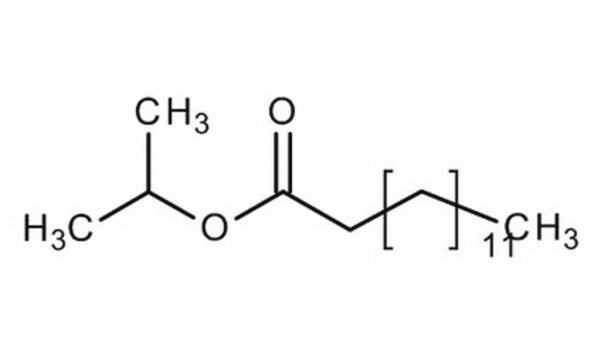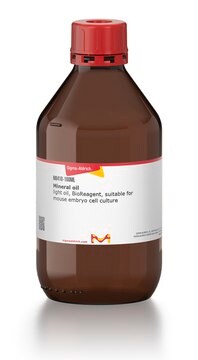172472
Isopropyl myristate
98%
Sinonimo/i:
Isopropyl tetradecanoate, Myristic acid isopropyl ester
About This Item
Prodotti consigliati
Livello qualitativo
Saggio
98%
Forma fisica
liquid
Indice di rifrazione
n20/D 1.434 (lit.)
P. eboll.
193 °C/20 mmHg (lit.)
Punto di fusione
~3 °C (lit.)
Densità
0.85 g/mL at 25 °C (lit.)
Stringa SMILE
CCCCCCCCCCCCCC(=O)OC(C)C
InChI
1S/C17H34O2/c1-4-5-6-7-8-9-10-11-12-13-14-15-17(18)19-16(2)3/h16H,4-15H2,1-3H3
AXISYYRBXTVTFY-UHFFFAOYSA-N
Cerchi prodotti simili? Visita Guida al confronto tra prodotti
Categorie correlate
Descrizione generale
Applicazioni
Codice della classe di stoccaggio
10 - Combustible liquids
Classe di pericolosità dell'acqua (WGK)
awg
Punto d’infiammabilità (°F)
>302.0 °F
Punto d’infiammabilità (°C)
> 150 °C
Dispositivi di protezione individuale
Eyeshields, Gloves, multi-purpose combination respirator cartridge (US)
Scegli una delle versioni più recenti:
Possiedi già questo prodotto?
I documenti relativi ai prodotti acquistati recentemente sono disponibili nell’Archivio dei documenti.
I clienti hanno visto anche
Il team dei nostri ricercatori vanta grande esperienza in tutte le aree della ricerca quali Life Science, scienza dei materiali, sintesi chimica, cromatografia, discipline analitiche, ecc..
Contatta l'Assistenza Tecnica.







